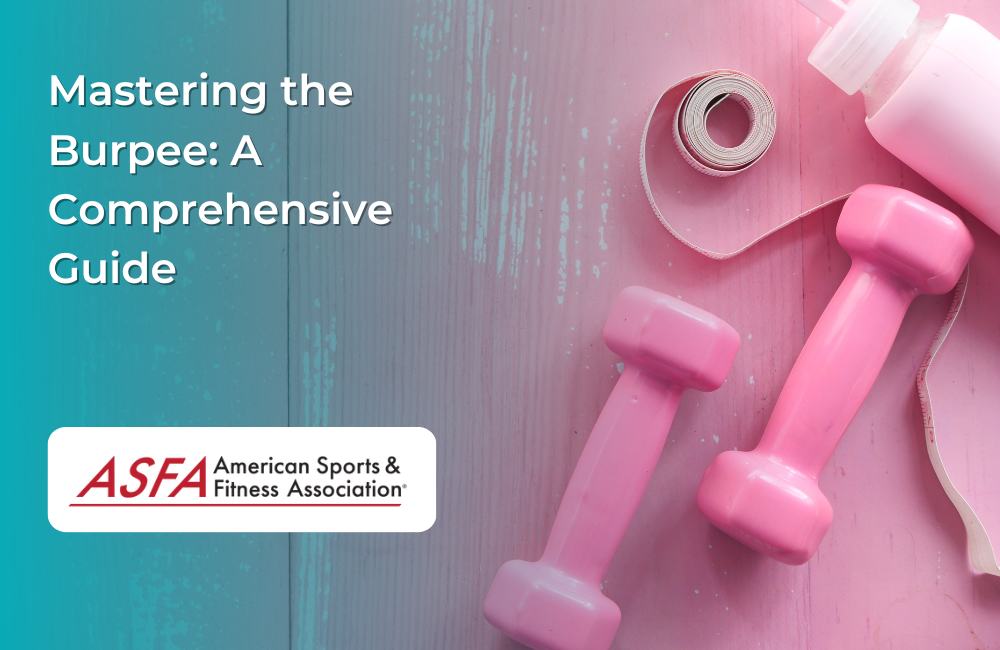The burpee is an iconic full-body exercise that has become a staple in fitness routines across the world. Highlighting its difficulty and competitive nature, an Australian woman set a record by completing 12,003 burpees in 24 hours. Combining cardiovascular conditioning, strength training, and coordination, the burpee is both simple in concept and challenging in execution. Its effectiveness in burning calories, improving endurance, and developing muscular strength makes it a go-to exercise for athletes, fitness enthusiasts, and personal trainers alike. This comprehensive guide will take you through the proper technique for performing burpees, offer detailed insights into its benefits, and explain why the American Sports and Fitness Association (ASFA) recommends this dynamic movement as a core part of any fitness regimen.
1. What is a Burpee?
At its core, a regular burpee is a multi-joint, multi-movement exercise that engages a wide range of muscles. It combines several foundational fitness moves into one fluid sequence. The burpee can be broken down into the following steps:
a) Starting Position:
-
Begin in a standing position with your feet shoulder-width apart, arms relaxed at your sides. Engage your core muscles, and maintain a neutral spine by standing tall with your chest open and shoulders down.
b) Squat:
-
Lower your body into a squat by bending your knees and pushing your hips back, similar to sitting down in a chair. Keep your weight evenly distributed across both feet, with your heels grounded and your knees tracking over your toes. Your chest should remain lifted, and your back straight. Engage your core to support the movement.
c) Plank Position:
-
Place your hands on the floor just in front of your feet, shoulder-width apart. As you plant your hands, jump or step your feet back into a plank position. In this position, your body should form a straight line from the top of your head to your heels. Keep your core engaged, your hips level, and avoid letting your lower back sag or your hips rise. The plank portion builds core stability and upper body strength.
d) Push-Up:
-
Lower your body towards the floor by bending your elbows. Keep your elbows close to your sides as you lower yourself into a push-up position. If you can, lower your chest until it is just above the floor. This portion engages your chest, shoulders, triceps, and core. Once you have lowered yourself, push back up to the plank position by straightening your arms.
e) Jump or Step Forward:
From the plank, quickly jump forward or step both feet forward, bringing your knees toward your chest. Your feet should land between your hands or as close as possible. If you’re a beginner, stepping one foot forward at a time can reduce the impact and make the movement more manageable.
f) Vertical Jump:
-
Once in a squat position, explode upwards, jumping into the air with your arms fully extended overhead. As you jump, fully extend your body and aim for height. Upon landing, absorb the impact by bending your knees slightly and returning to the standing position, ready to begin the next repetition.
2. Proper Technique and Detailed Tips
Executing the burpee with proper form is essential for maximizing its benefits while minimizing the risk of injury. Here are some detailed tips to help ensure you're performing the exercise correctly:
a) Maintain Proper Alignment:
-
Throughout the movement, keep your spine in a neutral position. Whether you're squatting, planking, or jumping, avoid rounding your back or allowing your hips to dip. Engaging your core is critical to maintaining alignment and protecting your lower back.
b) Control the Descent:
-
When moving into the push-up or plank position, don't rush. Control your body as you lower yourself, particularly during the push-up portion. Many people allow their hips to sag or their lower back to arch, which can lead to discomfort or injury over time. Keep your body in a straight line and focus on controlled movement.
c) Modify to Suit Your Fitness Level:
-
If you're new to burpees or find them challenging, modify the movement. Instead of jumping your feet back into the plank, step them back one at a time. If the push-up is too difficult, perform a knee push-up or omit it altogether. You can also step instead of jumping forward and eliminate the final jump until you build strength and endurance.
d) Gradually Increase Repetitions and Intensity:
-
Start with a small number of repetitions and focus on quality over quantity. Once you've mastered the proper form, gradually increase the number of burpees or include them in high-intensity interval training (HIIT) workouts to boost cardiovascular conditioning. As you progress, challenge yourself by adding variations like push-up burpees, jump burpees, or adding weights.
3. Detailed Benefits of Burpees
Incorporating burpees into your fitness routine can offer an array of benefits, targeting various aspects of physical health and performance:
a) Cardiovascular Conditioning:
-
Burpees are a high-intensity exercise that elevates your heart rate quickly, making them an excellent cardiovascular workout. The dynamic transitions from standing to plank to jumping increase oxygen demand, boosting cardiovascular endurance over time. Regularly performing burpees strengthens your heart and lungs, improving aerobic capacity and overall stamina.
b) Full-Body Strength and Muscular Endurance:
-
The burpee engages nearly every major muscle group. During the squat and jump, your legs (quads, hamstrings, glutes, and calves) work to propel you upward. The plank and push-up portions engage your core, shoulders, chest, and arms. This combination of movements helps to build functional strength and muscular endurance across your entire body, improving overall fitness and athletic performance.
c) Efficient Calorie Burner:
-
Because burpees are a full-body, high-intensity movement, they are incredibly effective at burning calories. According to fitness experts, performing burpees can burn upwards of 10 calories per minute, making them a great addition to fat-burning and weight-loss programs. Incorporating burpees into circuit training or HIIT sessions can significantly increase your calorie expenditure in a short period of time.
d) Improved Coordination and Agility:
-
The sequence of movements in a burpee requires a high level of coordination and agility. As you move from standing to squatting, into a plank, push-up, and jump, your body is constantly transitioning between different positions, which enhances your coordination. Over time, this can improve overall body awareness, balance, and agility, translating to better performance in sports and daily activities.
e) Time-Efficient Workout:
-
One of the standout features of burpees is how time-efficient they are. Because they engage multiple muscle groups and improve both strength and cardiovascular endurance, burpees offer a complete workout in a short time frame. Just a few minutes of burpees can provide a high-intensity workout that challenges your entire body.
f) Versatility and Adaptability:
-
Burpees are one of the most versatile exercises. They can be modified to suit any fitness level, from beginner to advanced. You can adjust the intensity by slowing down the movements, removing the jump, or substituting a step-back for the plank portion. Conversely, you can make them more challenging by adding a tuck jump, using dumbbells, or incorporating them into complex circuits. They fit well into almost any workout routine, from bodyweight workouts to strength training sessions.
4. Advanced Burpee Variations
As you master the standard burpee, you can explore advanced variations to keep challenging your body and prevent plateaus. Here are some variations to add diversity to your workout:
a) Burpee with Tuck Jump:
After the push-up, perform a tuck jump burpee by bringing your knees up towards your chest as you jump upwards. This adds a plyometric component, increasing the intensity and engaging your core and legs even more.
b) Single-Leg Burpee:
-
Perform the entire burpee sequence on one leg. This increases the demand on your balance and coordination, as well as placing extra stress on your core and lower body muscles.
c) Box Jump Burpee:
-
After performing the plank and push-up, jump onto a box or platform during the jumping portion. This variation adds an additional plyometric challenge and works on explosive power.
d) Dumbbell Burpee:
-
Hold a pair of dumbbells in your hands throughout the burpee. This variation increases the resistance and engages your upper body even more during the push-up and jump phases.
5. Incorporating Burpees into Your Workout Routine
Burpees are highly versatile and can be integrated into different workout styles to achieve specific fitness goals. Here are some ways to include burpees in your fitness routine:
-
Circuit Training: Include burpees as one of the exercises in a full-body circuit, alternating between strength exercises and cardio moves for a comprehensive workout.
-
HIIT Workouts: Use burpees in a high-intensity interval training format. Perform 30 seconds of burpees followed by 15-30 seconds of rest for several rounds to maximize calorie burn and cardiovascular endurance.
-
Strength and Conditioning: Add burpees as a finisher to your strength training routine to improve endurance and cap off your workout with a challenging full-body movement.
Conclusion
The burpee is a powerful, multi-functional exercise that offers a host of benefits, from improved cardiovascular fitness to increased strength and calorie burning. With its ability to engage multiple muscle groups and provide both aerobic and anaerobic conditioning, the burpee is a valuable addition to any workout routine. By mastering proper technique, gradually increasing intensity, and exploring advanced variations, you can harness the full potential of this exercise to achieve your fitness goals.
Whether you're aiming to improve endurance, burn fat, or build functional strength, the burpee can deliver impressive results in a time-efficient manner. As with any exercise, it's important to prioritize proper form, listen to your body, and progress at your own pace. If you're new to burpees or have any concerns about injury prevention, consider consulting with a certified fitness professional, such as those by ASFA, to ensure you're performing the movement safely and effectively.
With consistent practice and dedication, the burpee can become a cornerstone of your fitness routine, helping you reach new levels of health, performance, and overall well-being.





